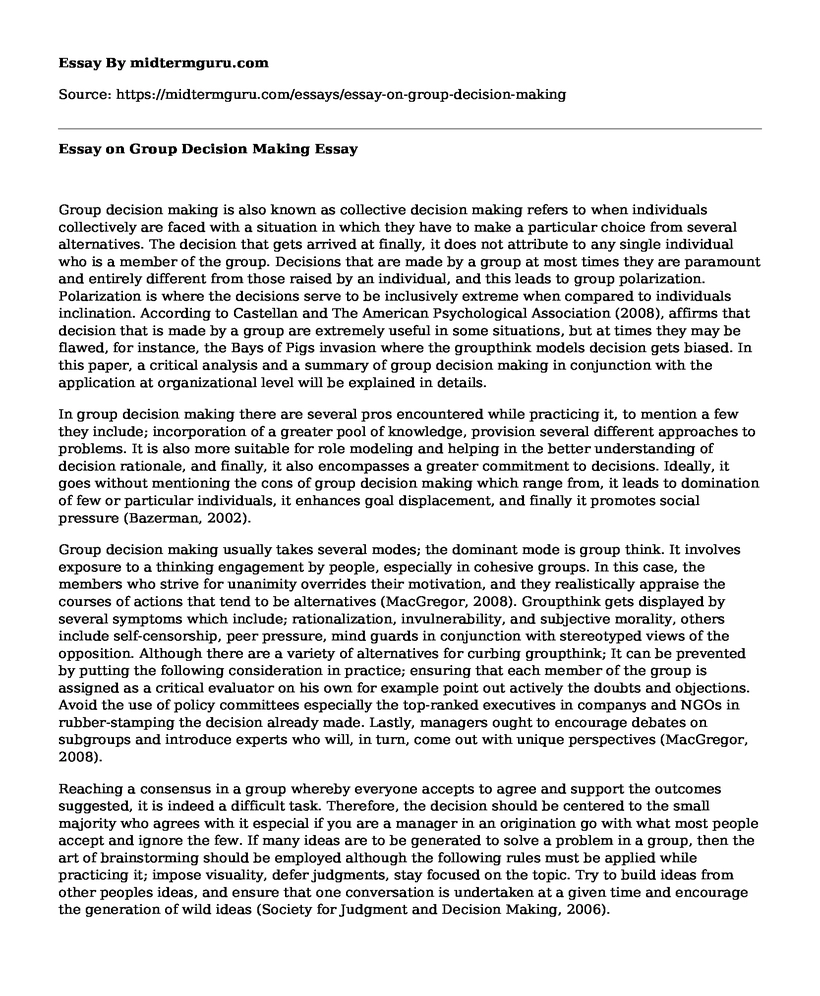Group decision making is also known as collective decision making refers to when individuals collectively are faced with a situation in which they have to make a particular choice from several alternatives. The decision that gets arrived at finally, it does not attribute to any single individual who is a member of the group. Decisions that are made by a group at most times they are paramount and entirely different from those raised by an individual, and this leads to group polarization. Polarization is where the decisions serve to be inclusively extreme when compared to individuals inclination. According to Castellan and The American Psychological Association (2008), affirms that decision that is made by a group are extremely useful in some situations, but at times they may be flawed, for instance, the Bays of Pigs invasion where the groupthink models decision gets biased. In this paper, a critical analysis and a summary of group decision making in conjunction with the application at organizational level will be explained in details.
In group decision making there are several pros encountered while practicing it, to mention a few they include; incorporation of a greater pool of knowledge, provision several different approaches to problems. It is also more suitable for role modeling and helping in the better understanding of decision rationale, and finally, it also encompasses a greater commitment to decisions. Ideally, it goes without mentioning the cons of group decision making which range from, it leads to domination of few or particular individuals, it enhances goal displacement, and finally it promotes social pressure (Bazerman, 2002).
Group decision making usually takes several modes; the dominant mode is group think. It involves exposure to a thinking engagement by people, especially in cohesive groups. In this case, the members who strive for unanimity overrides their motivation, and they realistically appraise the courses of actions that tend to be alternatives (MacGregor, 2008). Groupthink gets displayed by several symptoms which include; rationalization, invulnerability, and subjective morality, others include self-censorship, peer pressure, mind guards in conjunction with stereotyped views of the opposition. Although there are a variety of alternatives for curbing groupthink; It can be prevented by putting the following consideration in practice; ensuring that each member of the group is assigned as a critical evaluator on his own for example point out actively the doubts and objections. Avoid the use of policy committees especially the top-ranked executives in companys and NGOs in rubber-stamping the decision already made. Lastly, managers ought to encourage debates on subgroups and introduce experts who will, in turn, come out with unique perspectives (MacGregor, 2008).
Reaching a consensus in a group whereby everyone accepts to agree and support the outcomes suggested, it is indeed a difficult task. Therefore, the decision should be centered to the small majority who agrees with it especial if you are a manager in an origination go with what most people accept and ignore the few. If many ideas are to be generated to solve a problem in a group, then the art of brainstorming should be employed although the following rules must be applied while practicing it; impose visuality, defer judgments, stay focused on the topic. Try to build ideas from other peoples ideas, and ensure that one conversation is undertaken at a given time and encourage the generation of wild ideas (Society for Judgment and Decision Making, 2006).
In conclusion, it should be understood that group decision making is of greater importance in the solving of problems. While practicing group decision making, there are a few techniques that should be used, and these are; Delphi techniques in which the group processes eventually generates ideas anonymously from the physically dispersed experts in solving problems. Secondly, it is the decision support system method, and this is a computer-based where decision makers use models and data in addressing unstructured problems. When all these issues are well structured are taken care off, then decision making is of enormous importance (Castellan and American Psychological Association, 2008).
References
Bazerman, M. H. (2002). Judgment in managerial decision making. New York: Wiley.
Castellan, N. J., & American Psychological Association. (2008). Individual and group decision making: Current issues. Hillsdale, NJ: L. Erlbaum Associates.
MacGregor, M. G. (2008). Teambuilding with Teens: Activities for Leadership, Decision making & group success. Minneapolis: Free Spirit Pub.
Society for Judgment and Decision Making. (2006). Judgment and decision making. Berwyn, PA: Author.
Cite this page
Essay on Group Decision Making. (2021, Jun 02). Retrieved from https://midtermguru.com/essays/essay-on-group-decision-making
If you are the original author of this essay and no longer wish to have it published on the midtermguru.com website, please click below to request its removal:
- Stakeholder Role in BI Program and Organization BI Tool
- Essay on Decision Making Skills in Business Ownership
- Crisis Management Plan - Managment Paper Example
- Understanding Human Behavior and Its Relationship to Family Bonds - Essay Sample
- Article Analysis Essay on Women and Leadership: Selection, Development, Leadership Style, and Performance
- US Army Suicide: A Growing Mental Health Crisis - Essay Sample
- Reflective Paper Example on Teamwork







